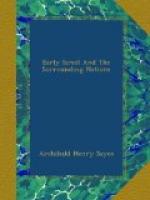Before Babylonian culture had been brought to the West, Amalek already existed. He was older than the oldest of the civilised kingdoms of the earth. But civilisation had raised a barrier against him which he was ever on the watch to break through. He never lost the opportunity of raiding the inhabitants of the cultivated lands, and escaping again into the desert with his booty before he could be overtaken and punished. The desert between Palestine and Egypt was his chief camping-ground. He had occupied the wadis of Mount Seir before the Edomites had entered them, and a part of the later population of the country traced its descent from a mixture of the Bedawi with the Edomite. The Egyptians had many names for the Bedawin hordes. Sometimes they were the Herusha or “Lords of the Sands,” sometimes the Shasu or “Plunderers,” sometimes again the Sute or “Archers.” The third name was borrowed from the Babylonians; in return, as we learn from the tablets of Tel el-Amarna, the Babylonians adopted the second.
Hardly had the Israelites escaped from Egypt when they were called upon to dispute with the Amalekites the possession of the desert. At Rephidim the Bedawin robbers fell upon the Israelitish camp. But they were beaten off with slaughter, and never again ventured to molest the people of Yahveh during their wanderings in the wilderness. The attack, however, was never forgotten, and vengeance was exacted for it in the reign of Saul. Then the Amalekites were pursued into their desert domain and mercilessly slaughtered. They had their home, it is said, in the desert which extended from Shur to Havilah. Shur was the line of fortification which defended the eastern frontier of Egypt, and ran pretty much where the Suez Canal has been dug to-day; Havilah was the “sandy” desert of northern Arabia. Here was the “city” of tents of which Agag was shekh, and which the troops of the Israelitish king burnt and spoiled.
But the remembrance of the expedition did not last long. When civil war had weakened the power of Saul, and the march of the Philistine army to the north had left the south of Canaan without defenders, an Amalekite tribe again poured into Judah and sacked the Philistine town of Ziklag. The wives and property of David and his followers were carried off into the wilderness. But the marauders were overtaken by the Israelites they had robbed, and summary vengeance taken upon them. Men, women, and children were alike put to the sword; four hundred only escaped through the fleetness of their camels.
In the Tel el-Amarna tablets we find the Bedawin and their shekhs playing a part in the politics of Canaan. Their services were hired by the rival princes of Palestine, and from time to time we hear of their seizing or plundering its cities on their own account. They have never ceased indeed to infest the land. Amalekite bands joined with the Midianites in devastating the villages of central Israel in the days of Gideon,




